I wrote this article on no-dig gardening versus digging in 2017 for Home Farmer magazine, sadly no longer with us. Since there were a few comments on my proposed no-dig experiment in my last post, I thought it may be worth popping the article up here, slightly altered for the web.
To Dig or Not to Dig?
I know as I sit down to write this that no-dig growing is one of those subjects that people get passionate about on both sides. It’s one of those internet forum topics that can get quite heated, to put it mildly. So, with some trepidation, my thoughts on the merits of the different systems.
No-Dig Growing Systems are Not New
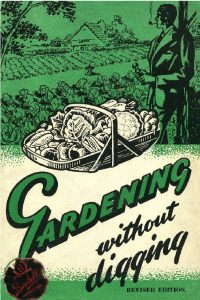 First of all, no-digging is not a new idea. Parisian market gardeners in the 19th Century used a no-dig method, continually adding huge amounts of rotted horse manure to their plots.
First of all, no-digging is not a new idea. Parisian market gardeners in the 19th Century used a no-dig method, continually adding huge amounts of rotted horse manure to their plots.
In this country Frederic Charles King (F C King) started experimenting with no-dig growing in the 1920s and published a pamphlet called Is Digging Necessary drawing heavily on Sir Albert Howard’s Indore composting system. This was published in 1946 and predated his later booklet The Compost Gardener
In 1948 BBC broadcaster Albert Guest published a booklet Gardening Without Digging, followed by Dalziel O’Brien in his Intensive Gardening of 1956 and James Gunston published Successful Gardening Without Digging in 1960.
Currently the best known champions of No-Dig gardening are Bob Flowerdew who practices it in conjunction with a raised bed system and Charles Dowding.
Why does anyone dig?
This does beg the question ‘if no-dig growing is so good, why does anyone dig over their plot nowadays?’
Many growers have seized on no-dig as an easy method of growing with the least and lightest work. However, the no-dig system is not without work. It requires a lot of compost and this may be more work producing than digging over would be.
Typically, no-dig systems involve the addition of 5cm of compost onto the growing beds annually. An average 250M2 (10 rods) allotment plot would require 12.5 cubic metres of finished compost each year. That’s a very large amount of compost. The system is usually combined with close-spaced planting and mulching to avoid bare ground.
In essence no-dig cultivation is very simple, composts and manures are lain on the surface and dragged below by worms, emulating the natural cycle where animal manures and dead plants, leaves etc. are just deposited on the surface. Some commercial market-gardeners have adopted the system with great success.
Conventional Cultivation with Digging
The initial dig is carried out by double digging. Here the topsoil is removed to either two spits (a spit is a spade depth) or to the level where the topsoil ends and the sub-soil begins.
The sub-soil is then broken up with a fork before manure or compost is laid in the trench above the forked-open sub-soil. This will percolate down into the sub-soil, encouraging worms and micro-flora to convert the sub-soil into top soil. The removed top soil is then replaced above it to dig the next trench.
Annually the soil is dug over to at least one spit deep in the autumn and left in large lumps. In the winter the freezing and thawing action breaks down these lumps into a finer consistency. In the spring this is further broken down with a cultivator and raked to create a fine tilth for seed sowing and planting.
Lime is just spread onto the surface to wash into the soil over the winter.
Cultivation with digging is a system that has been used for hundreds of years and is proven to produce good results. Digging over, especially double-digging can be hard work but with experience it does get easier.
Benefits of Digging and No Digging Methods
Digging
- Organic matter is introduced right next to the sub-soil increasing the depth of top soil quickly and encouraging worms to work lower in the soil.
- The soil is loosened and opened up allowing for easier water absorption and improving drainage.
- The looser soil allows higher levels of oxygen which is required by plants
- Nutrients that may have been washed down to lower levels in the top soil are redistributed throughout the top soil
- Hard pans are broken up allowing the top soil depth to increase and avoiding high water tables that can effectively root prune or even drown crops.
No-digging
- Labour saving in that no digging is required although this may be outweighed by the labour making the compost.
- Worms are encouraged by the surface mulch and draw this down into the lower levels opening up the soil and allowing easier water absorption and drainage.
- The worm’s action helps aerate the soil allowing oxygen to penetrate through their tunnels.
- The soil structure is maintained and the micro-flora especially symbiotic mycorrhizal fungi are minimally disturbed
- Because the soil is not inverted, weed seeds waiting to germinate are not brought to the surface so weeds should be less of a problem although the plot will still be susceptible to weed seeds blown in on the wind.
Green Manures in No-Dig Gardening
Most green manures that require digging in are not really compatible with a no-dig system but field beans can work well. When ready, cut the stem at ground level and compost the top leaving the roots in situe.
Mustard, so long as the plot is clubroot free, can also be useful. Just leave it standing until the first frosts kill it off allowing the stems to fall onto the ground. By the spring the worms should have dragged them into the soil but just plant through any left.
Raised Deep Beds
These are very popular and on some allotment sites nearly all the plots are on this system. In essence they’re not any different to no-dig systems except they get off to a flying start in year one due to them having a good depth of light top-soil & compost. I use these myself primarily for root crops.
Lasagne Beds
This is basically just a sheet composting system. Some of the variants I’ve seen are quite frankly ridiculously complicated. I’ve wondered if the proponents are just having a joke at the expense of the gullible. Still, each to their own.
Trials and Evidence on No-Digging Systems
Sadly I am not aware of any long-term research with comparative trials of the different systems apart from the Chase trial and that was back in 1947. Do let me know if you know different. What we do have is reports from individual growers and their experience along with some educated thinking to evaluate and compare different soil management practices.
The Chase No-dig vs Digging Trial
Mr Jocelyn L H Chase ran the trial at their Chertsey trial grounds over a period of 7 years. A plot was divided into two with half being run on a digging system as before and the other half on a no-dig system. Both were run organically.
Compost was applied equally at a rate of 30 tons per acre (approx 7.5Kg/M2) being spread on the surface of the undug plot and dug in with the other. The compost used on both plots came from the same heaps and was presumably identical in nutrients etc.
There was little difference between the two methods for the first three years although legumes and root crops did not do as well on the no-dig system other crops such as cucurbits and tomatoes performed significantly better.
In the fourth year of the trial the no-dig plot suffered a crash in fertility from which it did not recover during the trial. The conclusion drawn by Mr Chase was that a hybrid system of no-dig with triennial digging would be worth considering.
Interestingly the ladies who actually conducted the trial and who both held a BSc. (Hort.) commented that they felt additional weeding on the no-dig plot outweighed the labour saving benefit of not digging.
This was reported in the HDRA No-digging Report No 1 of 1969 produced by Lawrence D Hills. Apart from the Chase trial the rest of the report consisted of member’s experiences.
N.B. Some of the no-diggers also reported fertility crashes after 4 to 7 years.
My Conclusions
Based on my experience and research on the subject I would advise those growing on heavy clay soils to stick with conventional digging systems, preferably with double-digging at least every four years.
Those with lighter soils already in good heart with plenty of organic matter in them could well find a no-dig system productive and profitably use the time and effort previously devoted to digging in the production of more good quality compost to improve their plot. Because of the possible fertility crashes reported with some no-dig systems, incorporating a digging every four or five years would seem prudent.
For breaking new ground to grow vegetables, I would suggest that the proven digging system is generally best employed if possible but a lot depends on the initial condition of the land.
Compacted soils or shallow top soils will certainly benefit from an initial double dig but open deeper soils and lighter soils may do just as well, if not better, with a quick forking to open the surface and removal of perennial weeds followed by a deep compost mulch.
I’ll end with a quote from the No-digging Report No 1 by L D Hills
“We’re not concerned with proving whether any of the authors whose books are bibles for each separate cult of no-digger are ‘right’ or ‘wrong’. Our purpose is to find a blend of old and new methods that will help us garden with least and lightest work”

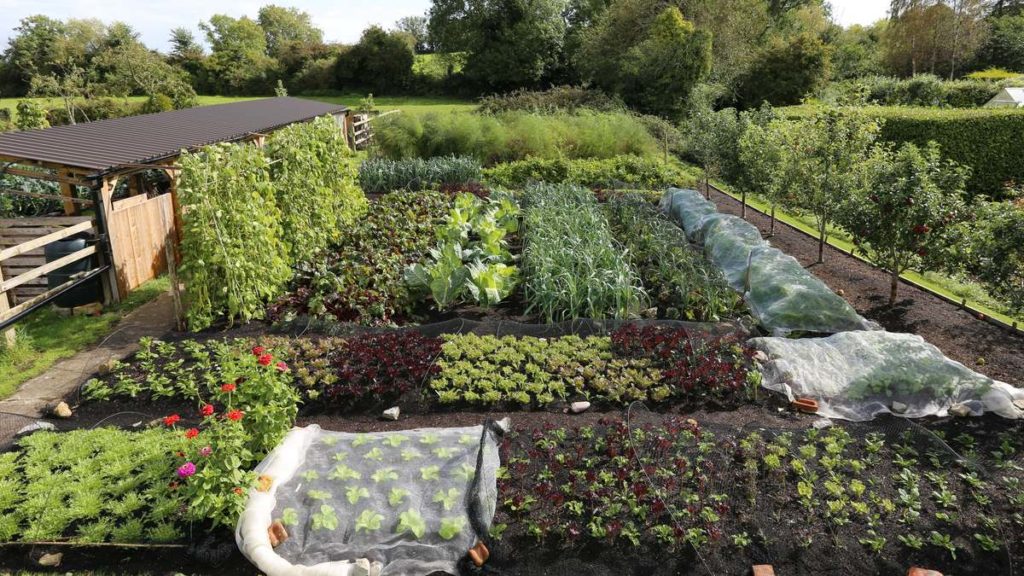
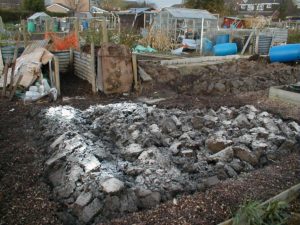
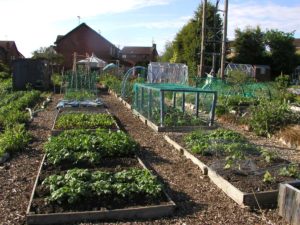
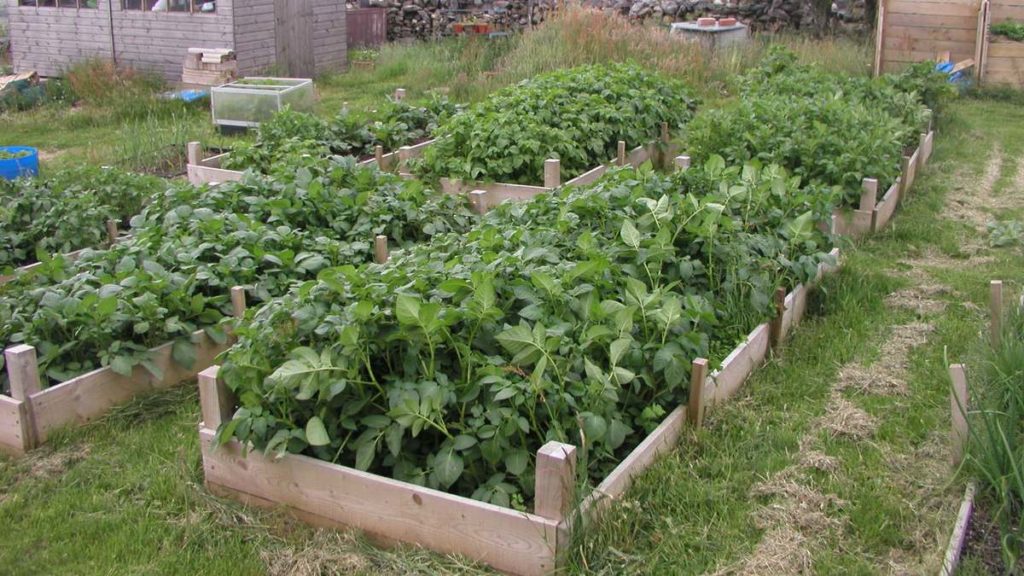
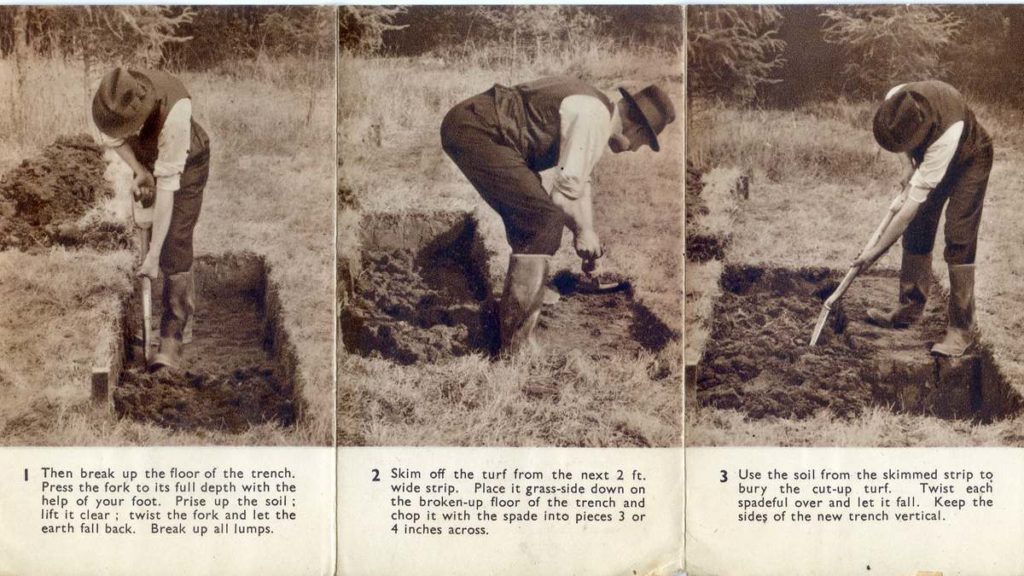



well you’ve certainly gone to town on this one John and I have to admit this info does make one look taking a step backwards and have a closer look at the no dig system
however as I’ve said on numerous occasions I’m not totally convinced about the no dig gardening so I wish to stay neutral although we do raised beds and open cultivation on our allotments
this no dig reminds me of the present day farming methods of minimum cultivation that’s supposedly more cost effective because there’s les time spent on labour and fuel cost’s and I’m not even convinced this minimum cultivation is a better way than ploughing the ground could this minimum cause of progressive growth of black grass that’s becoming a real pain for cereal growers
so back to dig or no dig that is the question I would need quite a lot of compost to cover the no dig system and would that be cost effective against my present way of rotation of manure and the introduction of green manure this season
and the other point if peat based compost to be discontinued 2020 will there be an alternative non peat based compost to give us the same results as peat based I’m not into organic composts or non peat based composts I’m afraid
looking at the no-dig gardening VS Digging do I stay with what I’ve learnt over the years or do I go for no dig that is yet to be decided
I think people need to think a bit more rather than jumping onto the latest growing fashion. No-dig certainly can make sense with the right underlying soil. You have to choose methods that work for you though.
With regards to peat in compost – the Irish are burning the stuff in power stations. I reckon they’d be better exporting it to us and buying in windmills with the money!
No till farming is a whole different ball game to home growing.
That is a very balanced view John and makes me think maybe our growing methods are good for the soil. We dig every four years when there is a potato crop in that bed on our 4 year rotation. I think the narrower beds you are trialling have a lot to offer and could be managed in this same way.
Thanks for such thought provoking reading
Thanks Kathy – interesting you mention the potatoes in the rotation, Bob Flowerdew said he felt they provided all the digging his no-dig plots required.
i must say your rite regarding the Irish peat couldn’t agree more but I beg to disagree with the no till farming so IL concede to agree to disagree
Actually I was thinking about pasture management when I replied – A senior moment!
I see what you mean on re-reading your post with my brain in gear 🙂
I’m pleased to have read this, as I have just been watching you tube videos on the subject of no digging, and it did look good! However in my new garden we have very heavy clay soil, so it probably wouldn’t work well!
I tried surface mulching with a range from compost to leafmould and rotted manure on a heavy clay soil and there didn’t seem to be any effect on the clay below.
The conventional double digging regime increased the depth of top soil and hugely improved drainage. After 5 years the depth of topsoil had increased by 18 ins (45 cm)
Don’t forget the importance of lime with clay soils – it improves flocculation (formation of larger particles) and really helps. If the soil pH is already high, gypsum has a similar effect but doesn’t increase the pH (as much)
its funny you should mention gypsum John as I understand gypsum from old plaster or plaster boards is being re-cycled back to a powder form and sold back to farmers for spreading on fields but I’m not sure what benefits are gained from spreading re-cycled gypsum its a bit technical for me being only a simple gardener
on the question of drainage farmers use a machine called a mole drain that they pull with a tractor in the ground the depth is basically like your double digging that improves field drainage like you have pointed out in your reply although I have never done double digging myself it does seem worth doing but I have to admit more labour intensive
There’s a couple of articles on the site about gypsum you might find interesting:
Gypsum, Using Gypsum in Gardening
and
Gypsum, A Valuable Input for Agriculture & Gardeners
There’s a refined version of the mole drain developed by Australian Yeomans called a Keyline Plough that breaks up sub-soil compaction to accelerate topsoil formation. Our fields aren’t suitable for any plough until they develop one that will go through boulders!!
Double digging isn’t much harder than single digging, really. The only extra is forking the bottom of the trench before adding the compost or manure.
I must have absorbed some wisdom from Bob Flowerdew back in the day lol. Our soil here is heavy clay with a compacted gravel pan about 6 to 10 ins down and with both plots the hardest job was to break up this pan to aid drainage in the growing areas and this involved digging. Plenty of lime helped the flocculation of clay particles and masses of organic matter has given us topsoil of dark crumbly soil of 15ins in depth after 7 years. Lovely stuff. The second plot is slowly improving at the end of the second year. It’ll get there. Plenty of worms now too and far fewer pernicious weeds
Thanks John will chase those articles up as I said I don’t do double digging but I plough the ground around nine inches each year and manure in rotation
Hi John thanks for the info on no-dig. On our allotments we have both diggers and no diggers and the only real difference between the systems is that generally the no diggers do far less weeding, the output of produce is roughly the same.
By the way Charles Dowding has results of dig v’s no dig trials over many years on his website.
The conclusion we have come to is if you like to dig, and some people do, that’s fine. The great thing about gardening over the last 50 years is I have found there is no right or wrong way as they say “you pay your money and make your choice.
All the best and thanks for a great website.
john me and my wife started a no dig in our allotment last year and the crop what we gown was beautiful and our potatoes were nice and clean we are doing it again this year
As an allotment owner I have divided my plot into three. I have 3 No dig beds , 3 raised beds, and a strip equal size for digging over.
This is to help me as I am over 75 and find digging large areas difficult now. Only started spring 2018 managed to grow a varied crop and am continuing thru the winter. Very interested in your article. Looking forward to a new year. Happy gardening to all however its done.
On our allotment site near York the Dig v No Dig has had a fair airing over allotment gates this past 12 months.
A group of us went to see Charles Dowding when he came to give a talk in York on the subject of No Dig. As is well documented Charles is one of the leading advocates of the system. His talk was very interesting & all our group enjoyed it. I will point out that I am now into my 5th year of No Dig on one of my allotments & I am hopefully starting to convert my second allotment to No Dig in the next couple of years. I initially started the process of conversion after meeting Charles about 6 years ago at Lindley Hall in London.
Many of my allotment “friends” were very sceptical but I have had very reasonable success with the system. I have several compost bins & stack horse manure every year to rot, luckily we get a plentiful supply delivered to our site. All the compost & well rotted manure plus used compost & leaf mould is all spread on the surface for nature & the worms to work with.
Three points, all the people who attended Charles talk are now experimenting with some No Dig! Personally it has somehow resolved the flooding issue on my main plot, a real bonus … my main downside I have a struggle to control bindweed with No Dig. So as with all gardening plusses & minuses with everything, but just enjoy your gardening!
Hi guys – having reached retirement, I am able to share my wife’s lifelong interest in allotmenteering and we took on a new plot two years ago which we have just about finished tidying up. My ‘old school’ wife favours digging and leaving the soil bare over winter, but I am not convinced – for allotmenteers, the difference in yield between dig and no-dig seems to be marginal.
Over the first winter, I planted grazing rye and winter tares in part of the plot and it grew very well. A few weeks before the bed was needed, I cut it all down and covered it with brown mulch and permeable membrane. The green manure showed no signs of re-growing and everything my wife planted did well – but she still complained that the soil felt ‘hard’ just below the surface (our soil is clay).
I’m just a rookie but I’m of the opinion that, if you like digging, then go dig – digging definitely offers its own pleasure and satisfaction. But, if you don’t want to dig, then grow green manure and kill it by cutting it and covering it.
Over winter, a nicely dug bed of bare soil looks very nice – but so does a growing bed of healthy green manure.
That’s interesting, Ken. I’d be a bit concerned about a clay pan lower down from what you say. Rather than dig, it might be worth just plunging a fork down and rocking it to open up the clay, aiding the worms in getting the good stuff above down and improving the top soil depth.
Hi John – here’s a follow-up to my earlier comment (I’m still a rookie who is mostly interested in experimenting with compost-making, no-digging and green manuring – it’s my wife who has a lifetime’s experience in vegetable growing, and I leave that side of things entirely to her).
Bob Flowerdew has commented on the idea of cutting and covering a green manure crop in order to kill it and incorporate it and I am definitely of the opinion that it is not always necessary for a green manure to be ‘dug in’ in the conventional manner. The idea, so far as I understand it, is that the root system of a suitable cover crop will go some way towards opening up the sub-soil as an alternative to deep digging.
You mention field beans as a green manure which needs no digging in. I sowed some field beans last November because I had left it too late to sow anything else but they took so long to germinate and then grew so slowly that they never really provided any kind of canopy to protect the soil surface from the elements. If I use field beans again, I will sow them earlier and much closer together than recommended – I might even sow them through holes in some thin cardboard.
You also mention mustard, but I don’t know if our plot has any clubroot (my wife hasn’t yet grown any brassicas in our two-year tenancy). I guess growing some mustard might be a good way to find out.
Finally, here is an idea I have thought of for dealing with Hungarian grazing rye. I plan to rake the top soil to the edges of the bed and cover it with a thick layer of goodies such as comfrey leaves, compost and cardboard. I will then sow the rye in the main area of the bed in the hope that it will root more deeply into the subsoil. In the spring, I will chop down the crop (but leave it in situ) and rake the top soil back over the entire bed. After a month under a permeable plastic membrane, I reckon the bed will be good to go.
Have a good summer! Ken
Sir, I am currently undergoing an experiment c0mparing n0-dig techniques with digging techniques on a half allotment plot in Kettering, Northants. The site is divided into 7 no-dig beds and 7 dig beds. I am growing exactly the same crops in each half. Last year I grew Alliums and root crops, this year it is the turn of the legumes. Each bed is treated the same way. My aim is to look at the effects on the soil food web, weeding, organic soil matter, soil structure, soil nutrients, decomposition of organic matter, pests and diseases, beneficial soil fungi, the retention of soil moisture and thus watering regimes. Although I shall also look at crop yields I do not intend that to be-all and end-all of it. I have been going for 2 years so far and intend to do at least another 2 years.
Dear John, what a fascinating article and discourse. I went to Caythorpe Agricultural College during the 60’s to waste some (4 years) of my youth! And at that time we had a couple of fields that were ‘no-til’ trials and all cultivation was done, if at all, on the top 2 or 3 inches of soil just once per year. The idea being that any crop residue and subsequent fertiliser would be sufficient. The trial did not last long, there were weed problems, there were fertility problems, and as I remember we ended up having to spray some pretty nasty stuff (Gramoxone) on there to sort the problem out. The whole lot was then ploughed in.
Now; on my allotment, I have a no-dig area that I am playing with and so far it has worked a treat, but I have the time to look after it. Work on it most weeks and I am not leaving it for an entire crop without doing any further work (as in an agricultural situation). But, a major problem I have is in creating enough compost even for my small no-dig area – it has to share what I make with the rest of the plot. To treat my entire plot like that I reckon I’d spend more time making compost than I would in digging over the whole plot and incorporating a good layer of FYM, which I have easy access to, once a year.
I am very much grateful for your efforts put on this article.
This article is transparent, updated and extremely informative.
Can I expect you will post this sort of some other article in near future?
King regards,
Abildgaard Dencker
I had read out of curiosity but I am not convinced this is the way forward on cultivation. Lots fields have bind weed, by not digging them off, they will just multiply and form a parallel network below the ‘no dig’ soil where they will continuously take off the nutrition of the soil below where otherwise plants that have deep roots like tomato, would be benefitting from that nutrition. Besides, the time saved on digging would be offset by making huge amounts of compost which I find it a bid daft. Buying it would be an expensive exercise and not really very sustainable. In a few years time, the soil level would be quite high too… what would one do to bring the soil level down to ground level, where would it go? At our allotment, the experienced guys do digging and their crop yields are very high, more than the beginners who have started no dig and hope for the best. Having monitored them, I am not convinced the meagre crop growing there justifies huge piles of compost they had bought and added to their plots. I strongly believe that digging, crop rotation and underground irrigation are key to great harvests.